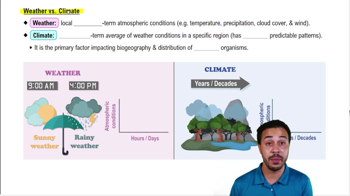Table of contents
- 1. Introduction to Biology2h 40m
- 2. Chemistry3h 40m
- 3. Water1h 26m
- 4. Biomolecules2h 23m
- 5. Cell Components2h 26m
- 6. The Membrane2h 31m
- 7. Energy and Metabolism2h 0m
- 8. Respiration2h 40m
- 9. Photosynthesis2h 49m
- 10. Cell Signaling59m
- 11. Cell Division2h 47m
- 12. Meiosis2h 0m
- 13. Mendelian Genetics4h 44m
- Introduction to Mendel's Experiments7m
- Genotype vs. Phenotype17m
- Punnett Squares13m
- Mendel's Experiments26m
- Mendel's Laws18m
- Monohybrid Crosses19m
- Test Crosses14m
- Dihybrid Crosses20m
- Punnett Square Probability26m
- Incomplete Dominance vs. Codominance20m
- Epistasis7m
- Non-Mendelian Genetics12m
- Pedigrees6m
- Autosomal Inheritance21m
- Sex-Linked Inheritance43m
- X-Inactivation9m
- 14. DNA Synthesis2h 27m
- 15. Gene Expression3h 20m
- 16. Regulation of Expression3h 31m
- Introduction to Regulation of Gene Expression13m
- Prokaryotic Gene Regulation via Operons27m
- The Lac Operon21m
- Glucose's Impact on Lac Operon25m
- The Trp Operon20m
- Review of the Lac Operon & Trp Operon11m
- Introduction to Eukaryotic Gene Regulation9m
- Eukaryotic Chromatin Modifications16m
- Eukaryotic Transcriptional Control22m
- Eukaryotic Post-Transcriptional Regulation28m
- Eukaryotic Post-Translational Regulation13m
- 17. Viruses37m
- 18. Biotechnology2h 58m
- 19. Genomics17m
- 20. Development1h 5m
- 21. Evolution3h 1m
- 22. Evolution of Populations3h 52m
- 23. Speciation1h 37m
- 24. History of Life on Earth2h 6m
- 25. Phylogeny2h 31m
- 26. Prokaryotes4h 59m
- 27. Protists1h 12m
- 28. Plants1h 22m
- 29. Fungi36m
- 30. Overview of Animals34m
- 31. Invertebrates1h 2m
- 32. Vertebrates50m
- 33. Plant Anatomy1h 3m
- 34. Vascular Plant Transport2m
- 35. Soil37m
- 36. Plant Reproduction47m
- 37. Plant Sensation and Response1h 9m
- 38. Animal Form and Function1h 19m
- 39. Digestive System10m
- 40. Circulatory System1h 57m
- 41. Immune System1h 12m
- 42. Osmoregulation and Excretion50m
- 43. Endocrine System4m
- 44. Animal Reproduction2m
- 45. Nervous System55m
- 46. Sensory Systems46m
- 47. Muscle Systems23m
- 48. Ecology3h 11m
- Introduction to Ecology20m
- Biogeography14m
- Earth's Climate Patterns50m
- Introduction to Terrestrial Biomes10m
- Terrestrial Biomes: Near Equator13m
- Terrestrial Biomes: Temperate Regions10m
- Terrestrial Biomes: Northern Regions15m
- Introduction to Aquatic Biomes27m
- Freshwater Aquatic Biomes14m
- Marine Aquatic Biomes13m
- 49. Animal Behavior28m
- 50. Population Ecology3h 41m
- Introduction to Population Ecology28m
- Population Sampling Methods23m
- Life History12m
- Population Demography17m
- Factors Limiting Population Growth14m
- Introduction to Population Growth Models22m
- Linear Population Growth6m
- Exponential Population Growth29m
- Logistic Population Growth32m
- r/K Selection10m
- The Human Population22m
- 51. Community Ecology2h 46m
- Introduction to Community Ecology2m
- Introduction to Community Interactions9m
- Community Interactions: Competition (-/-)38m
- Community Interactions: Exploitation (+/-)23m
- Community Interactions: Mutualism (+/+) & Commensalism (+/0)9m
- Community Structure35m
- Community Dynamics26m
- Geographic Impact on Communities21m
- 52. Ecosystems2h 36m
- 53. Conservation Biology24m
48. Ecology
Introduction to Ecology
Problem 16`
Textbook Question
What biome do you live in? Describe your climate and the factors that have produced that climate. What plants and animals are typical of this biome? If you live in an urban or agricultural area, how have human interventions changed the natural biome?
 Verified step by step guidance
Verified step by step guidance1
Identify the biome you live in based on geographical location, climate, and natural vegetation. Common biomes include tropical rainforests, deserts, tundras, and temperate forests.
Describe the climate of your biome, including typical temperature ranges, precipitation patterns, and any seasonal variations that are characteristic of the area.
Discuss the natural factors that influence the climate of your biome. This could include latitude, elevation, nearby bodies of water, ocean currents, and prevailing winds.
List typical plants and animals that are native to your biome. Mention any adaptations they have that enable them to survive and thrive in the environmental conditions of the biome.
Examine human impacts on your biome, such as urban development, agriculture, or deforestation. Discuss how these interventions have altered the natural landscape, climate, and biodiversity of the region.
 Verified video answer for a similar problem:
Verified video answer for a similar problem:This video solution was recommended by our tutors as helpful for the problem above
Video duration:
1mPlay a video:
Was this helpful?
Key Concepts
Here are the essential concepts you must grasp in order to answer the question correctly.
Biome
A biome is a large ecological area on the Earth's surface, characterized by specific climate conditions, flora, and fauna. Biomes are classified based on factors such as temperature, precipitation, and the types of organisms that thrive in those environments. Examples include deserts, forests, grasslands, and tundras, each supporting distinct ecosystems and biodiversity.
Recommended video:
Guided course

Introduction to Aquatic Biomes
Climate Factors
Climate factors include temperature, humidity, precipitation, and wind patterns that define the weather conditions of a region over time. These factors influence the types of vegetation and animal life that can survive in a biome. For instance, a biome with high rainfall and warm temperatures typically supports dense forests, while arid conditions lead to desert ecosystems.
Recommended video:
Guided course

Weather vs. Climate
Human Impact on Biomes
Human activities, such as urbanization, agriculture, and deforestation, significantly alter natural biomes. These interventions can lead to habitat destruction, changes in species composition, and the introduction of invasive species. Understanding these impacts is crucial for conservation efforts and for maintaining biodiversity within affected biomes.
Recommended video:
Guided course

Geographic Impact on Communities
Related Videos
Related Practice

































































































